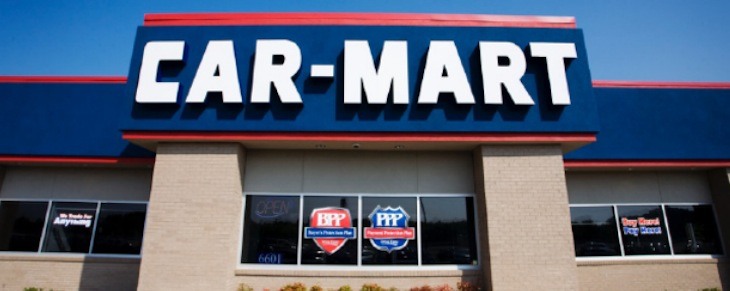Car-Mart customers return as deep subprime lending hits record low
by January 9, 2018 4:18 pm 937 views

Deep subprime lending has tightened in the used car industry, and America’s Car-Mart expects to see customer traffic increase. But the level at which the Bentonville-based buy here, pay here used car dealer will see it rise is uncertain, President and CEO Jeff Williams said.
“Many of the larger finance companies have tightened up their credit standards after seeing higher losses, especially those specializing in the deep subprime market,” Williams said. “Eventually this means that some people that previously could obtain financing through third party finance companies may have a harder time obtaining financing now.”
In the third quarter of 2017, deep subprime lending fell to a record low in the used car industry, according to Experian. The percentage of buyers who received a used car loan with deep subprime credit, or a credit score of 500 or less than, declined to 4.64%, from 5.11% in the same period in 2016.
While more potential customers might make their way to a Car-Mart dealership as a result of the tightened standards, Williams said plenty of financing is still available.
“We have seen some of our previous customers that had left a few years ago coming back,” he said. “Many of them were tempted by offers where they might get a little bit lower payment due to the longer term but realized after a few years that due to the high interest rate and very long term, they still owed almost as much as when they purchased the vehicle.”
Average term lengths for used car buyers with deep subprime credit have increased 0.4 months to 58.52 months, according to Experian.
“I think the term loans are so long that, at least in the near term, they shouldn’t increase much more,” Williams said. “In the longer term, as the price of vehicles continue to get larger the terms very well could get longer in order for the payments to stay affordable.”
The average term length for Car-Mart loans has risen but are much shorter than the average used car loan. The average term length for new loans is less than 30 months, Williams said. In the second quarter that ended Oct. 31, the average term length for Car-Mart’s 69,900 active auto loans rose to 32.5 months, from 31.7 months in the same period in 2016.
“We try very hard to balance keeping our vehicles affordable and still making sure our customers can build equity in their vehicle and ultimately succeed in paying off their vehicle and getting their title in hand,” Williams said. “We know that for most of our customers their vehicle is a necessity and not a discretionary purchase.”
In the second quarter, Car-Mart’s average vehicle price fell 0.7% or $73 to $10,418. Accounts more than 30 days past due fell to 4.1%, from 4.8%. Net charge-offs declined to 7.5%, from 7.7%. Charge-offs relate to the losses from repossessions and are the difference between the loan amount and the money received from selling the vehicle on the wholesale market.
Shares of Car-Mart (NASDAQ: CRMT) closed Tuesday (Jan. 9) at $44.90, down 75 cents or 1.64%. In the past 52 weeks, the stock has traded between $49.40 and $30.20.
NATIONWIDE LOAN, PRICE AVERAGES
The average used car loan amount for deep subprime buyers rose $204 to $14,837, according to Experian. The percentage of loans more than 30 days past due have risen to 2.43%, from 2.4%.
In Arkansas, the percentage of loans 30 days past due is 2.78%. Across the used car industry, the share of financing provided by buy here, pay here dealers rose 0.1 percentage points to 11.6%, from the same period in 2016. Banks provided the most used car financing, but it declined 2 percentage points to 36.1% over the same period.
The amount of used car financing by credit unions increased 2 points to 28.4%.
In December, the Manheim Used Vehicle Value Index fell 1.9%, from November, as used vehicle prices continued to decline after major hurricanes led prices to rise in August. The index rose 5.6% to 132 in December, from the same month in 2016, and was at the lowest level since August.
“Most gains since August were a result of the replacement demand following the devastation of Hurricanes Harvey and Irma,” said Jonathan Smoke, chief economist for Cox Automotive, parent company of Manheim. “Used vehicle values are now returning to pre-storm levels. Underlying vehicle deprecation rates have been accelerating to catch up to where prices would have been without the abnormal demand and scarce supply in both September and October.”
Used car sales increased 4% in December, from the same month in 2016. The seasonally adjusted annual rate of sales increased 1% to 39 million in 2017. In 2018, the sales rate is projected to rise another 1% to 39.5 million, Smoke said. He expects used vehicle values to be weak in the first quarter as the Internal Revenue Service again delays income tax returns for households who receive the child tax credit. He expects demand to improve by March as tax returns arrive and take home pay increases for nearly 80% of households as a result of tax reform.
By the end of 2018, the Manheim Used Vehicle Value Index should rise 3% to 136, Smoke said.
